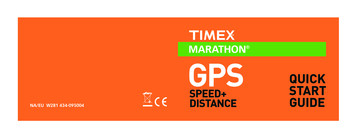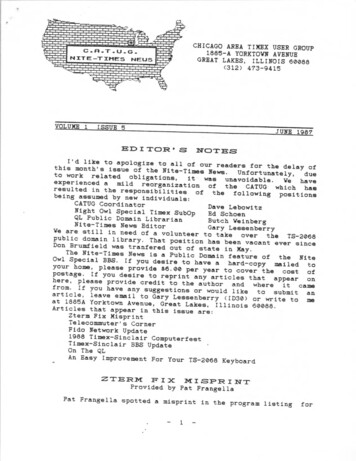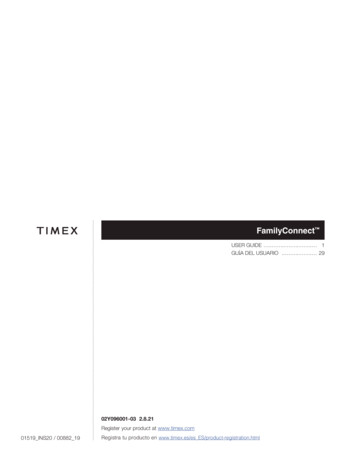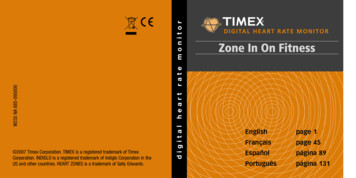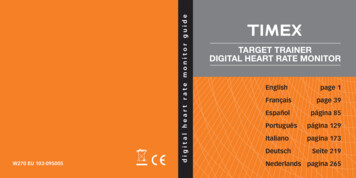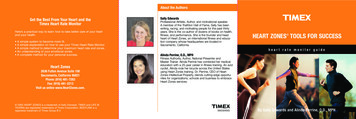
Transcription
About the Authors:Get the Best From Your Heart and theTimex Heart Rate MonitorHere’s a practical way to learn how to take better care of your heartand your health. A simple system to become more fit.A simple explanation on how to use your Timex Heart Rate Monitor.A simple method to determine your maximum heart rate and zones.An understanding of your emotional zones.A complete method for your personal success.Heart Zones2636 Fulton Avenue Suite 100Sacramento, California 95821Phone: (916) 481-7283Fax: (916) 481-2213Visit us online www.HeartZones.com. 2005 HEART ZONES is a trademark of Sally Edwards. TIMEX and LIFE ISTICKING are registered trademarks of Timex Corporation. BODYLINK is aregistered trademark of Timex Group B.V.Sally EdwardsProfeesional Athlete, Author, and motivational speaker.A member of the Triathlon Hall of Fame, Sally has beenwriting, racing, and motivating people for the past thirtyyears. She is the co-author of dozens of books on health,fitness, and performance. She is the founder and headheart of Heart Zones, an international fitness and education company whose headquarters are located inSacramento, California.HEART ZONES TOOLS FOR SUCCESSheart rate monitor guideAlinda Perrine, O.D., MPHFitness Authority, Author, National Presenter andMaster Trainer. Alinda Perrine has combined her medicaleducation with a 25-year career in fitness training. An avidcyclist, Alinda rode her bicycle across the United Statesusing Heart Zones training. Dr. Perrine, CEO of HeartZones Intellectual Property, blends cutting-edge opportunites for organizations, schools and business to embraceHeart Zones services.990094560By Sally Edwards and Alinda Perrine, O.D., MPH
Heart Zones Tools for Success:The Timex Heart Rate MonitorAlinda Perrine, O.D., MPH&Sally Edwards, MA, MBA
Table of ContentsWelcome to The Timex Heart Rate Monitor Guide, thefirst book in the Heart Zones Tools for Success series.Page NumberWelcome to the Tools for Success Series.3Chapter 1.Introducing the Heart Rate Monitor6Chapter 2.Estimating Your Maximum Heart Rate12Chapter 3.Introducing Heart Zones15Chapter 4.The Heart Zones Point System21Chapter 5.Putting It All Together:The Heart Zones Training ProgramAPPENDIX2629 Acknowledgements30 Disclaimer31 Heart Zones322There is an old saying: If you have your health, you have everything. We at HeartZones would like to make one change: if you have a healthy heart, a happier lifewill follow. This book may help you lose weight, get faster, go farther or evenhelp you become more attractive and sexier. But most importantly, this bookpromises that by using the tools offered inside, you can achieve optimal physical, emotional, and metabolic health, thus becoming healthier and happier.As the folks at Timex say: “Life is Ticking. ”What are the Tools for Success?Tools for Success is the first book of the series and it has two key components:1. Timex Heart Rate Monitor. With this wonderful piece of technology, youcan look inside your body and see your heart in action! “beats per minute” isdisplayed on the watch of your monitor, second by second, so that you knowexactly how your heart is responding to an ever-changing environment.Whether you are inside working at a desk, or outside working out in the sun,wind, or rain, your heart rate monitor can guide you to improved health andhappiness.2. Heart Zones Training System: Heart Zones, a fitness training and education company, offers you a cutting-edge training system whose key componentis your heart rate. We designed the Heart Zones Program to increase thestrength and endurance of your heart, the most important muscle in your body.3
How Will Tools for Success Benefit Me?If you are just starting on the road to fitness or returning to it after a break, youcan expect to: Have more energy and feel stronger. Accomplish more in your day with less stress. Follow a program tailored to your heart and your level of fitness, notsomeone else’s.If you are fit but would like to improve, you can expect to:Enjoy working out more.Burn fat more efficiently.Train smarter.If you are already a serious athlete, Tools for Success shows you: The way to train less and get more benefit from it. If you race, forexample, our biofeedback and training program will help you increase yourspeed. How to monitor your effort and workload, creating a precision trainingprogram.The Timex Heart Rate Monitor allows you to measure how hard you areexercising. You can then take that data and develop a customized trainingprogram using the Heart Zones system. With these two unbeatable tools, weguarantee you will cross new thresholds of personal fitness.It happens every time.Dr. Alinda PerrineDr. Alinda Perrine, CEO of Heart Zones Intellectual Property, LLCSally EdwardsSally Edwards, the Head Heart of Heart Zones How is the Heart Zones Program Different from OtherFitness Programs?Most fitness programs focus on factors such as the distance you cover or thelength of time you work out. The Heart Zones program focuses on theintensity level of your exercise, measured in heart beats per minute. “Zones”refer to five different levels of graduated intensity. 2004 Sally Edwards and Alinda Perrine.45
Chapter 1. Introducing the Heart Rate MonitorHow Your Heart Rate Monitor WorksWe are pleased to introduce the Timex Heart Rate Monitor: your new bestfriend, personal coach, and workout partner. This amazing tool opens a windowthat allows you to see how the most important muscle in your body — yourheart — responds throughout the day. Your heart rate provides an objectivegauge of physical exertion and emotional stress, one that's usually more exactthan your own perceptions. With this critical information in hand, you can beginto improve your overall health.There are two basic parts to a Heart Rate Monitor: the sensor and the receiver.The sensor detects and records the electrical activity of your heart via pads orelectrodes located on the back of the sensor (the elastic chest strap keeps thesensor in contact with your skin). Your heart rate data is then broadcast fromthe sensor to the receiver or “heart watch” that displays the beats per minute(bpm).This chapter covers how to assemble, put on, and use your Heart Rate Monitor.You’ll also find some simple exercises to get you comfortable with using yourmonitor.Congratulations on investing in one of the coolest new pieces of fitness andhealth technology available today — the Timex Heart Rate Monitor. You havejust purchased the best heart rate technology available today. This wearabletool will transform your workouts and your total health. So get ready: you arecrossing over the threshold of a brand new way to connect your mind and body.Did You Get Everything?Inside your Heart Rate Monitor box, you should find: Receiver or “heart watch” Sensor (transmitter) Elastic chest strap User’s guide Book: Heart Zones Tools for Success: The Timex Heart Rate Monitor6If your tool is digital, you do not need to worry about interference from highvoltage power lines, televisions, workout equipment, mobile phones, or othersources of electromagnetic energy.To turn on the monitor, push a button (see your User’s Guide for completeinstructions) on the receiver until you see a heart-shaped icon on the display.When the icon starts to flash, the monitor is “on” and receiving data from thesensor.Do you have a number on the watch display? Good, because now you are readyto open the lines of communication with your heart.Digital heart rate monitor receivers lock-in on a unique signal. They do not“cross talk” or pick up signals from other monitor users. However, if two individuals start their digital monitors at the same instant, it is possible that theywill lock-in on only one signal, not two distinct signals. To prevent this situation,start your monitors a few seconds apart and stand at least six feet away fromeach other when you start your monitors.7
Watch Your Heart in Real TimeWhat Do the Numbers Mean?Ok, your sensor is strapped on and you are getting your first look at youramazing heart in action. The flashing heart icon on the face of your watch isyour heart beating in real time. Stare at it for a minute. Ideally, you are seeing asteady, rhythmical pattern, the sign of a healthy heart.Your Heart Rate Monitor displays the number of beats—or the number of timesthat your heart contracts—per minute. If you did the exercises listed in Table 1(see pg. 10), you saw your heart rate fluctuate based on factors such as: Your body position (standing, sitting, or lying down, for example) The type of activity that you are doing (walking, running, playing a game) The duration or length of time that you are moving The level of intensity at which you are exercising Your current level of energy or fatigue How fit you areYour Heart Rate Monitor reflects your total stress. Hence, a high number onyour monitor indicates a higher intensity level of your exercise, or a higher levelof emotional stress or increased metabolic activity. Likewise, a lower numberindicates a lower level of physical or emotional stress.The heart rate number changes every few seconds as the frequency of yourheartbeats change. This is known as “updating” and your Heart RateMonitor updates every two seconds. Ignore the first few numbers that you seebecause the software inside the receiver needs to sample enough data to beaccurate. In other words, give it a little time to be precise.Experiment and Have Fun with Your MonitorOn page 10 are some simple activities that allow you to observe how your heartresponds on three different levels: emotional, metabolic, and physical. Try themout as your first activity and record your results!Tip from the Heart: If you notice erratic numbers, tighten yourelastic chest strap, which will improve the contact between thesensor pads and your skin. If you see no numbers or the hearticon is not flashing, moisten the sensor pads.8Tip From the Heart:Your heart is unique and responds to your individual physiology.So it’s important to understand there is no right number for anactivity, but rather a range of numbers that is normal for youand only you. So it doesn’t make sense to compare your heartrate responses to another person’s results, or to think thatthere are “good” or “bad” heart rates. Your numbers, your heartrates depend on you.9
TABLE 1ActivityType1. StandingPhysicalStand in place for two minutesand record your “standing” heartrate.bpm2. SittingPhysicalSit quietly for two minutes andrecord your “sitting” or ambientheart rate.bpmPhysicalLie down quietly and record your“prone” heart rate.bpmPhysicalTake a five-minute walk and atthe end of the walk, record yourheart rate.Read the cartoon section of yourpaper or a book that makes youlaugh out loud.Call a friend that you dearly loveon the phone and share with himor her how much you care.bpm3. Lying down4. Taking a walkEmotional5. LaughingEmotional6. Talking to a friend7. Eating comforttemperature9. Eating a large meal10bpmbpmEmotionalbpmMetabolicPut on a heavy jacket and pantsand wait for five minutes as yourbody responds to an increase inyour internal thermal temperature.bpmMeasure your heart rate justwhen you are hungry and againafter you have eaten a largemeal.bpmDrink any caffeinated beverage(such as coffee) or eat a foodwith caffeine (such as chocolate).Measure the increase in heartrate, minute by minute, for 10minutes.bpmMetabolic10. Drinking or eating afood or beveragecontaining caffeineBeats perMinute (bpm)Eat “comfort food” (often foodsyou ate in childhood) and recordyour heart rate five minutes afteringestion.food8. Raising your bodyDescriptionMetabolicWhy Should I Use a Heart Rate Monitor?Of all the personal health equipment you own, the Heart Rate Monitor may beyour most valuable one because only the monitor can measure theintensity level of your exercise. Your heart rate is the only number that isessential. Why? That is because your heart rate provides a true index of yourcurrent fitness level and a solid way to measure fitness improvement.You can use your Heart Rate Monitor to: Assess fitness: Measure your improvement as you get in shape and staythere. Monitor stress: Keep tabs on what causes your heart rate to rise duringthe day. Motivate yourself: Maintain the physical and emotional zones that are bestfor you. Manage your energy: Burn more fat as the primary fuel of your workout. Organize workouts: Lead yourself through a variety of workouts such as“steady state,” “intervals,” and “hills.”For example, if you are working out too hard, the monitor can act as a brakeand keep you in the right zone. Or if you are facing a stressful situation at work,it can remind you to take a few deep breaths and relax. On the other hand, youcan count on your monitor to tell you if you are taking it too easy during anexercise session and need to increase the pace.In Chapter Two, you’ll learn more about your heart rate and how to use it toimprove your fitness.11
Chapter 2. Estimating Your Maximum Heart RateThe best way to know what the numbers on your monitor mean is to put theminto context: that is, the range of heart beats per minute that is normal for you.To establish this range, you need to know your maximum heart rate.In this chapter, you’ll learn how to estimate your maximum heart rate—thecornerstone of your personalized Heart Zones training program.3. Watch your monitor as your heart rate increases. Write down your heart rateat the end of the 3-minute period. This is called your “final heart rate.”4. Add your fitness factor to the “final heart rate” number to arrive at your estimated maximum heart rate.Step Test Fitness FactorFitness Level NowFitness FactorPoor 35Average 45Excellent 55Fit 65Your maximum heart rate is the greatest number of beats per minute that yourheart can contract. Everyone’s maximum is different and there is no accuratemathematical formula to calculate it. You can discover your maximum heartrate by taking a few simple tests.For example, if your final heart rate is 140 bpm and you are in average shape,your estimated maximum heart rate is 185 bpm (45 140 185 bpm).Sub-Max Step and Chair TestsSub-Max Chair TestOk, ready to go? First, you will take two tests each called “sub-maximum”because they are designed to keep your heart working well below its maximumheart rate. When you are done, you will estimate your maximum heart rate bycombining the results of both tests.Again, please warm up adequately before performing the test.Sub-Max Step TestMake sure to warm up adequately before performing these tests.1. On any step that is approximately eight inches in height begin a four-countsequence of stepping up and down as follows: right foot up, left up, rightdown, left down.2. Perform thirty (30) step sequences per minute in the sequence “up, up,down, down” for a period of three minutes, totaling 90 steps.121. Sit down on the seat of the chair and then stand up again. Perform thisexercise set in a rhythmic fashion, thirty times in one minute. You can moveto the cadence of “one second stand up” and “one second down sit down.”Keep your arms relaxed and at your sides.2. Watch your heart rate monitor as your heart rate increases and note yourfinal heart rate number.3. Add your fitness factor (see chart below) to arrive at your final heart ratenumber.Chair Test Fitness FactorFitness Level NowFitness FactorPoor 50Average 60Excellent 70Fit 8013
The sum of your final heart rate plus your fitness factor is the estimate of yourmaximum heart rate. For example: If your peak heart rate is 120 bpm and youare in excellent shape, your estimated maximum heart rate is the sum of thesetwo numbers: 120 70, or 190 bpm.Calculating Your Maximum Heart Rate from Test ResultsNow that you have the results of two different sub-maximum tests, average thenumbers together as an estimate of your true maximum heart rate as shownbelow:Chair-test estimate Step-test estimate 2 Your estimated maximumheart rateTip From the Heart: Did you know your maximum heart rate is: The highest number of contractions per minute that yourheart can beat. A relatively fixed number, unless you become unfit. Activity specific. Genetically set. Can be over 200 bpm for children. Can be affected by drugs and altitude. Does not decline with age. Cannot be determined by a mathematical formula. Provides the number to use as the cornerstone for your “heart zones.”Chapter 3. Introducing Heart ZonesThe Heart Zones training system is different from other exercise systemsbecause it focuses on the intensity of your exercise — not the distance youcover or the length of time you work out. What matters the most if you want torecuperate from an illness, get fit, or run a marathon? You need to control yourexercise intensity. How do you know the intensity level? By using your TimexHeart Rate Monitor.Do you know a runner who trains steadily but never seems to get faster? Doyou know someone who faithfully walks a couple of miles per day, but doesn’treally seem to improve? These problems would be easy to solve within theHeart Zones training system. For example, the runner may always run at thesame level of intensity or zone and may simply need to vary the pace of his orher runs to get faster. The walker may need to walk a little faster and harder forpart of the two miles, to gain endurance and strength.The Heart Zones training system comprises a framework of five progressivelychallenging heart rate “zones.” The program’s cornerstone is that all importantnumber you discovered in Chapter Two — your maximum heart rate.Remember, your heart zones are personal: they reflect your genetic heritageand your current level of fitness.Ideally you should work out in different zones on different days to get differentbenefits.Now that you that have your maximum heart rate number, let’s look at how touse this information.1415
Calculating Your Five Heart ZonesTo calculate your five heart zones, look at Chart 1 below and circle thenumber on the top line that corresponds most closely with your maximumheart rate. The numbers in the column below your maximum heart rate areyour five training zones.CHART 1Look at Chart 1 again. Each zone reflects units of ten percent of yourmaximum heart rate. For example, if your maximum heart beats per minute is200 then your range of beats per zone is 20. In this example, Zone One is thelowest range: 100 to 120 bpm. Zone Two is 120 to 140 bpm, and so on. The floorof Zone One is 100 bpm. The ceiling of Zone One is 120 bpm.Note that the lower the maximum heart rate, the fewer the number of beatsper zone. Conversely, the higher the maximum heart rate , the more beats perzone. More beats per zone does not make you a better or worse athlete.Athletic performance is not based on your maximum heart rate or the numberof beats in your zone.Zone QuizCan you answer the questions below based on the Heart Zones maximum heartrate chart?1. If your maximum heart rate is 200 bpm, what is the floor of Zone Two?2. If your maximum heart rate is 165 bpm, what is the middle of Zone Four?3. If your maximum heart rate is 185 bpm, what number is eighty percent ofyour maximum?This chart is enlarged and shown in color on the inside back cover.Answers: 1. 120 bpm162. 140 bpm3. 148 bpm17
What Are The Five Different Zones?The heart zones reflect five levels of intensity. Each of these levels or zones isbased on human physiology. As you move up through the zones, metabolic andphysiological events change. For example, your body’s energy source changesand the amount of carbohydrates and fat vary.In the Heart Zones training system, each zone is 10 percent (10%) of your maximum heart rate. Each zone has a name and a color. See the color chart on theback cover pullout. The name refers to the benefit gained by spending exercisetime within that zone. The color shows how hot or cool the zone is. The lowzones are blue and green because they are lighter or cooler intensities. The toptwo zones are orange and red because they are progressively higher and hotter.Zone One is the lowest percentage of your maximum heart rate. In this zone,the body’s metabolism starts to wake up. Zone 1 benefits include a lower bloodpressure and lower cholesterol. Few calories are burned, but Zone 1 is a greatstarting place.Zone Two is the Temperate Zone. It is a comfortable, cruise zone. You can talkin Zone 2. More calories are burned than in Zone 1 and your fat is starting tomove out of the cell.Zone Four is the Threshold Zone, indicating a tougher place to workout. Workingin this zone a couple of days per week will help improve your fitness level andget faster. Too much work in Zone Four can cause overtraining. Lots of caloriesburned and you must eat to replace carbohydrates.Zone Five is the highest percentage of maximum heart beats. It is a high, hot,hard zone with the highest number of calories burned. As you get very fit, ZoneFive will help improve your performance, but you should not stay there or overtraining may result.Spending time in different zones gives you different benefits. For example, ZoneFour workouts make you stronger, but too many Zone Four workouts withoutrest may lead to overtraining. Zone Two workouts are great for recovery orendurance building, but staying in Zone Two for too many workouts may keepyou from increasing your personal fat-burning range.Basic Heart Zones Training WorkoutIt is important to organize your workouts to get the most benefit in the leastamount of time. Here’s an example of a workout that is planned using the HeartZones training system.Zone Three is a sweat zone: the Aerobic Zone. At 70% to 80% of your maximumheart rate, exercising in Zone Three results in improved functional capacity ofblood vessels and aerobic capacity. For fitness lovers, Zone Three is a happyzone because endorphins are released and more calories are burned.1819
Chapter 4. The Heart Zones Points SystemYour first Heart Zones workout with your Timex Heart Rate Monitor. Workout: 30 minute run/walk Warm up: 3 minutes from bottom of Zone 1 or 50% of your maximumheart rate to the midpoint of Zone 2 or 65% of yourmaximum heart rate Skill: 3 minutes midpoint of Zone 2 to the floor of Zone 3 Main Set: 21 minutes7 minutes midpoint of Zone 37 minutes ceiling of Zone 37 minutes midpoint of Zone 3 Cool Down: 3 minutes midpoint Zone 2 to floor of Zone 1The Heart Zones Points system developed by Sally Edwards is a way to keeptrack of your exercise based on your fitness goals. For example, do you want tomaintain your current weight? Then you need to work out to the tune of 7001,000 points per week. Are you just starting an exercise program? You’re looking at 300-500 points per week. Getting ready for a Triathlon? 1,500 to 2,500 oreven more points per week. In this chapter, you are going to learn how to exercise just the right amount by measuring your “training load.”For years, athletes have asked: “How fast did I run? How hard did I cycle? Howmuch training is enough or too much?” What they are really asking is how toestimate their training load. Training load is the sum of three parts: duration ofeach workout, exercise intensity, and the number of exercise sessions.Calculate Your Training LoadTraining load can be calculated easily as follows:Frequency (# of workouts) x Intensity (Zone Number) x Time (minutes) Training LoadThis equation is known as the “FIT equation” where F is frequency, I is intensity, and T is exercise time. The result of this equation is a number, the numberof Heart Zones training points.For example, if you run for twenty minutes at Zone Three intensity, you haveearned sixty points (20 minutes x 3). If you are aiming for 300 points per week,assuming five workouts per week, you’ve done it! That is 5 workouts x Zone 3x 20 minutes 300 Heart Zones training points.2021
What is the optimal training load or number of Heart Zones training points foryou? The answer is “it depends”— it depends on your physiology, your goals,and your current fitness level.Look at the chart below to help determine how many weekly training pointsyou need. For a more extensive list, refer to The Heart Rate Monitor GUIDEBOOKby Sally Edwards.Select Your Training Goal Below:Begin an exercise programMaintain current weightFinish a 10K raceRide your bike 100 miles in one dayComplete a marathon (26.4 miles)Complete an Ironman-type triathlon(Swim 2 miles, bike 112, run 26.4 miles)Recommended HeartZone Points (per week)300-500 points700-1,000 points800-1,000 points1,200- 1,400 points1,500-1,800 points1,500- 2,700 pointsHere’s an example. A friend recently wanted to do her first sprint triathlon. Shewrote a training plan and determined her weekly Heart Zones training points.She knew that if she slowly and progressively increased her points starting at500 for the first week and finishing the last week of her training at 1,200, shecould finish. And, she did just that.At first, your ability to work within zones will depend on your fitness level, sogo slowly to prevent overtraining and injury. And remember: use these numbers(points per week) as your guide. Adjust your training plan if necessary. You mayneed to add more or you may need to decrease the number of Heart Zonestraining points. Be flexible and patient with yourself because what is important22is that you are training with a plan and using a Timex Heart Rate Monitor — yournew training partner.Training Load RulesThe following rules should provide a little thrust to your training program. Make Exercise a Habit: Make daily exercise a regular habit and add up yourpoints! If your points fall below 300, add another work out to your week orincrease your movement time for each workout. Ten Percent Limit: Increase your training load by no more than tenpercent per week. Rate Not Pace: At first, it’s more important to know your heart ratethan your speed or pace. Keep a Training Log: Keep track of your training time, number of workoutsper week, and zones. Calculate your training load weekly by using a traininglog. Percentages Not Rate: It’s easier to train using a percentage (the relativenumber) than the absolute (the whole number). For example, training ateighty percent is easier to understand than training at 148 bpm.Remember rules are your guides, not the law.Logging is Important for Your SuccessOne of the most important keys to success is keeping a log of your workouts.Chart your progress. Measure your success. Most of us need proof of successto motivate us to keep going. Take John, a recreational athlete, for example. Heset a goal of 1,000 Heart Zones training points per week in order to run his first23
10K race. Each week he faithfully kept his log to ensure that he accomplishedhis weekly goal. John believes that without his log, he would not have crossedthe finish line two minutes faster than planned.Look at the previous print-out from the Data Recorder The graph is called a“heart rate profile.” It provides you with an “at-a-glance” review of your heartrates during the session.There are two types of training logs: paper or electronic.If you want to get the most out of your heart rate monitor, then use it to manage your training. It is much more than a speedometer that measures how fastyour heart is beating; rather, it is a management tool. We know that we can bestmanage what we can monitor and measure. And, now, with your Timex heartrate monitor, you have that power. Use it for every workout and listen toyour heart.Heart Zones designed the HRM logbook for those who log manually. Check itout at www.heartzones.com! You can also download a sample fromwww.timex.com/fitness. Or you can use the Timex’s digital Data Recorder. TheData Recorder collects your heart rate numbers, which you can then downloadto your personal computer. It also provides a method for keeping track of yourtime in each zone, so that you can determine your training points. If you use theTimex Bodylink System which includes the Speed Distance feature, the DataRecorder keeps a record of your speed, pace, heart rate, elapsed time, and distance traveled.2425
Chapter 5. Putting It All Together: The Heart ZonesTraining ProgramCHART 2Whatever your age, level of fitness, or gender, it takes a lot of heart, inspirationand confidence, to achieve your best health and happiest times. We have talkedabout physical fitness, but there are two other vital components to the program: metabolic and emotional fitness. Your heart and your Timex heart ratemonitor are the link to all three.Emotional Fitness TrainingNourishing a sound mind and sound body is a daily activity anda responsibility.Today, more than ever, scientists show us how the effects of stress can makefat and can lead to disease and illness. Psychologists tell us that negative emotions such as anger and fear can lead to metabolic disorders, and, in somecases, are linked to heart diseases.Just as there are five different physical heart zones, there are five emotionalheart zones. As you review the Heart Zones Emotional Chart 2 that follows, younotice there are five different emotional zones. In each zone, the body createsa different hormonal, neurological, and biochemical response.For more information visit www.heartzones.com.COLOR CHART AVAILABLE AT WWW.HEARTZONES.COM2627
Heart Zones Training PledgeTake CareWe’d like to offer you one last tool that may help you “go the distance” inyour quest for optimal health. The Heart Zones Training Pledge is about you,your willingness to get in touch with your heart and your willingness to useyour heart rate monitor as a fitness tool. Read the pledge, sign it, post it, lookat it daily, and then reread it as often as you need in order to make the positive changes you desire.I desire an improvement in my life.I will wear my heart rate monitor for every workout.I will measure my estimated maximum heart rate to set my heart zones.I will wear my heart rate monitor all day for three days and record tenmeasu
years. She is the co-author of dozens of books on health, fitness, and performance. She is the founder and head heart of Heart Zones, an international fitness and educa-tion company whose headquarters are located in Sacramento, California. About the Authors: Alinda Perrine, O.D., MPH Fitness Authority, Author, National Presenter and Master Trainer.
